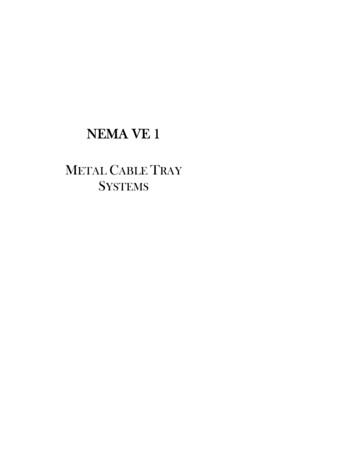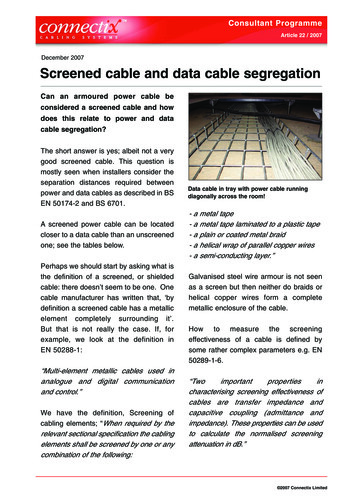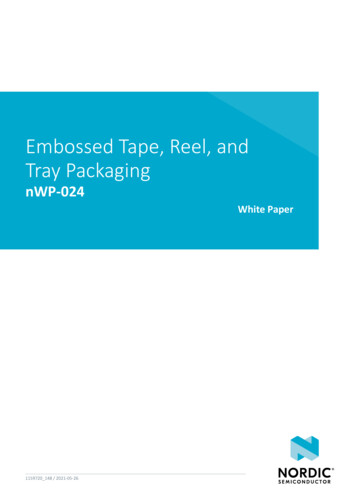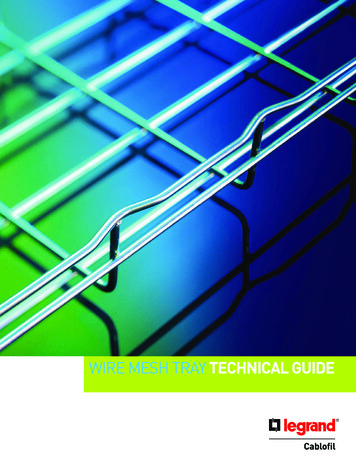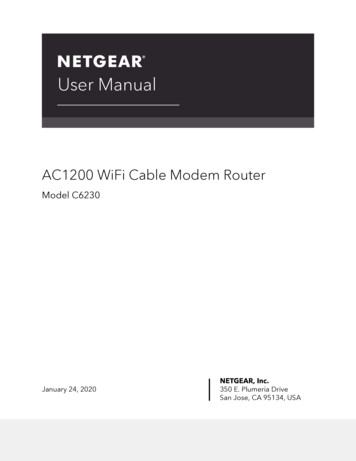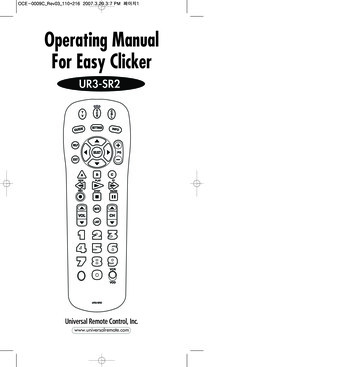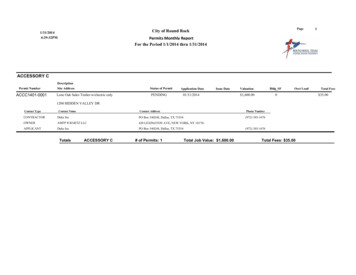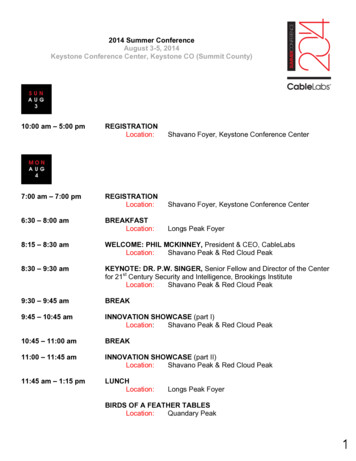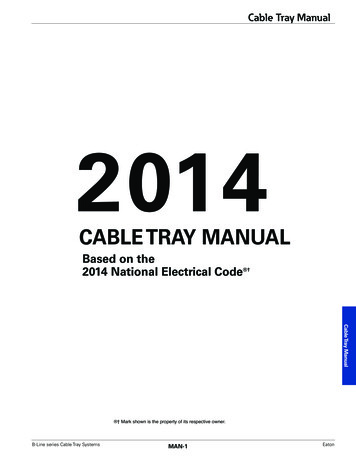
Transcription
Cable Tray Manual2014CABLE TRAY MANUALBased on the2014 National Electrical Code †Cable Tray Manual † Mark shown is the property of its respective owner.B-Line series Cable Tray SystemsMAN-1Eaton
Cable Tray ManualTable of ContentsPage No.Introduction.MAN-3Why Cable Tray?Cable Tray ManualSafety . MAN-4Dependability . MAN-4 – MAN-5Space Savings . MAN-5Cost Savings . MAN-5 – MAN-8An In-depth Look at the 2011 NEC , Section 392Types of Cable Trays (NEC 392.1 Scope) . MAN-9 – MAN-10EMI/RFI Cable Tray . MAN-10Cable Tray Materials . MAN-11392.2 Definition of Cable Tray System . MAN-11392.10 Uses for Cable Tray . MAN-11 – MAN-16(A) Wiring Methods and Cable Types . MAN-12 – MAN-13(B) Industrial Usage . MAN-13 – MAN-14(1) Single Conductor Cable . MAN-13 – MAN-14(2) Medium Voltage Cable . MAN-14(C) Hazardous (Classified) Locations . MAN-14 – MAN-16(D) Usage of Nonmetallic Tray . MAN-16392.12 Uses Not Permitted . MAN-16392.18 Cable Tray Installation . MAN-16 – MAN-20(A) Complete System . MAN-16 – MAN-18(B) Completed Before Installation . MAN-18(C) Covers . MAN-19(D) Through Partitions & Walls . MAN-19(E) Exposed & Accessible . MAN-19(F) Adequate Access . MAN-19(G) Raceways, Cables, Boxes, and Conduit Bodies Supportedfrom Cable Tray Systems . MAN-19 – MAN-20392.20 Cables and Conduit Installation . MAN-21 – MAN-22(A) Multiconductor Cables, 600V or less . MAN-21(B) Cables Rated over 600V . MAN-21(C) Connected in Parallel . MAN-21 – MAN-22(D) Single Conductor . MAN-22392.22 Number of Conductor of Cable . MAN-23 – MAN-26392.30 Securing and Supporting Cables and Conductors . MAN-26392.46 Bushed Conduit and Tubing . MAN-27392.56 Cable Splices . MAN-27392.60 Grounding and Bonding . MAN-28 – MAN-31392.80 Ampacity of Conductors . MAN-31 – MAN-33392.100 Construction Specifications . MAN-33 – MAN-35(A) Strength and Rigidity . MAN-33 – MAN-35(B) Smooth Edges . MAN-35(C) Corrosion Protection . MAN-35(D) Siderails . MAN-35(E) Fittings . MAN-35(F) Nonmetallic Cable Tray . MAN-35Cable Tray Wiring System Design and Installation Hints . MAN-36Cable Tray Accessories . MAN-37Fireproofing Tray . MAN-37Cable Tray Maintenance & Repair . MAN-37Expansion and Contraction . MAN-38 – MAN-39Appendix Index & Appendix Sheets . MAN-40 – MAN-47Cable Tray Sizing Flowchart . MAN-48 – MAN-49Cable Tray Installation & Specification Checklists . MAN-50 – MAN-51Footnotes . MAN-52EatonMAN-2B-Line series Cable Tray Systems
Cable Tray ManualINTRODUCTIONThe B-Line series Cable Tray Manual was produced by our technical staff. We recognize the needfor a complete cable tray reference source for electrical engineers and designers. The followingpages address the 2014 National Electrical Code requirements for cable tray systems as wellas design solutions from practical experience. The information has been organized for use as areference guide for both those unfamiliar and those experienced with cable tray. Nearly every aspect of cable tray design and installation has been explored for the use of thereader. If a topic has not been covered sufficiently to answer a specific question or if additionalinformation is desired, contact the engineering department at B-Line. We sincerely hope you willfind the Cable Tray Manual a helpful and informative addition to your technical library.The information contained herein has been carefully checked for accuracy and is believed to becorrect and current. No warranty, either expressed or implied, is made as to either its applicabilityto, or its compatibility with, specific requirements, of this information, nor for damages consequentto its use. All design characteristics, specifications, tolerances and similar information are subjectto change without notice.Cable Tray ManualEatonB-Line Division509 West Monroe StreetHighland, IL 62249-0326Tel: (800) 851-7415www.eaton.com/b-lineseriesNFPA 70 - 2014, National Electrical Code and NEC are registered trademarks of theNational Fire Protection Association, Quincy, MA.Reproduced with permission from NFPA 70 -2014, National Electrical Code , Copyright 2013, National Fire ProtectionAssociation, Quincy, MA. This reprinted material is not the complete and official position of the NFPA on the referencedsubject, which is represented only by the standard in its entirety. B-Line series Cable Tray Systems MAN-3Eaton
Cable Tray ManualWHY CABLE TRAY?BECAUSE A CABLE TRAY WIRING SYSTEM PROVIDESSAFE AND DEPENDABLE WAYS TO SAVE NOW AND LATERLarge numbers of electrical engineers have limiteddetail knowledge concerning wiring systems. There isthe tendency by engineers to avoid becoming involvedin the details of wiring systems, leaving the wiringsystem selection and design to designers orcontractors. Certain decisions must be made for anywiring system installation, and these decisions shouldbe made in the design and construction activities' chainwhere maximum impact is achieved at the lowestpossible cost. Deferring design decisions toconstruction can result in increased costs and wiringsystems incompatible with the owner's futurerequirements. Early in the project's design life, thecosts and features of various applicable wiringsystems should be objectively evaluated in detail.Unfortunately, such evaluations are often not madebecause of the time and money involved. It isimportant to realize that these initial evaluations areimportant and will save time and money in the longrun. The evaluation should include the safety,dependability, space and cost requirements of theproject. Many industrial and commercial electricalwiring systems have excessive initial capital costs,unnecessary power outages and require excessivemaintenance. Moreover, the wiring system may nothave the features to easily accommodate systemchanges and expansions, or provide the maximumdegree of safety for the personnel and the facilities.Cable tray wiring systems are the preferred wiringsystem when they are evaluated against equivalentconduit wiring systems in terms of safety,dependability, space and cost. To properly evaluate acable tray wiring system vs. a conduit wiring system,an engineer must be knowledgeable of both theirinstallation and the system features. The advantagesof cable tray installations are listed below andexplained in the following paragraphs.Cable Tray Manual Safety Features Dependability Space Savings Cost Savings Design Cost Savings Material Cost Savings Installation Cost & Time Savings Maintenance SavingsCABLE TRAY SAFETY FEATURESA properly engineered and installed cable tray wiringsystem provides some highly desirable safety featuresthat are not obtainable with a conduit wiring system. Tray cables do not provide a significant path for thetransmission of corrosive, explosive, or toxic gaseswhile conduits do. There have been explosions inindustrial facilities in which the conduit systems were aEatonlink in the chain of events that set up the conditions forthe explosions. These explosions would not haveoccurred with a cable tray wiring system since theexplosive gas would not have been piped into a criticalarea. This can occur even though there are seals in theconduits. There does have to be some type of anequipment failure or abnormal condition for the gas toget into the condu
CABLE TRAY MANUAL Based on the 2014 National Electrical Code † Cable Tray Manual 2014 Cable Tray Manual B-Line series Cable Tray Systems MAN-1 Eaton † Mark shown is the property of its respective owner.
